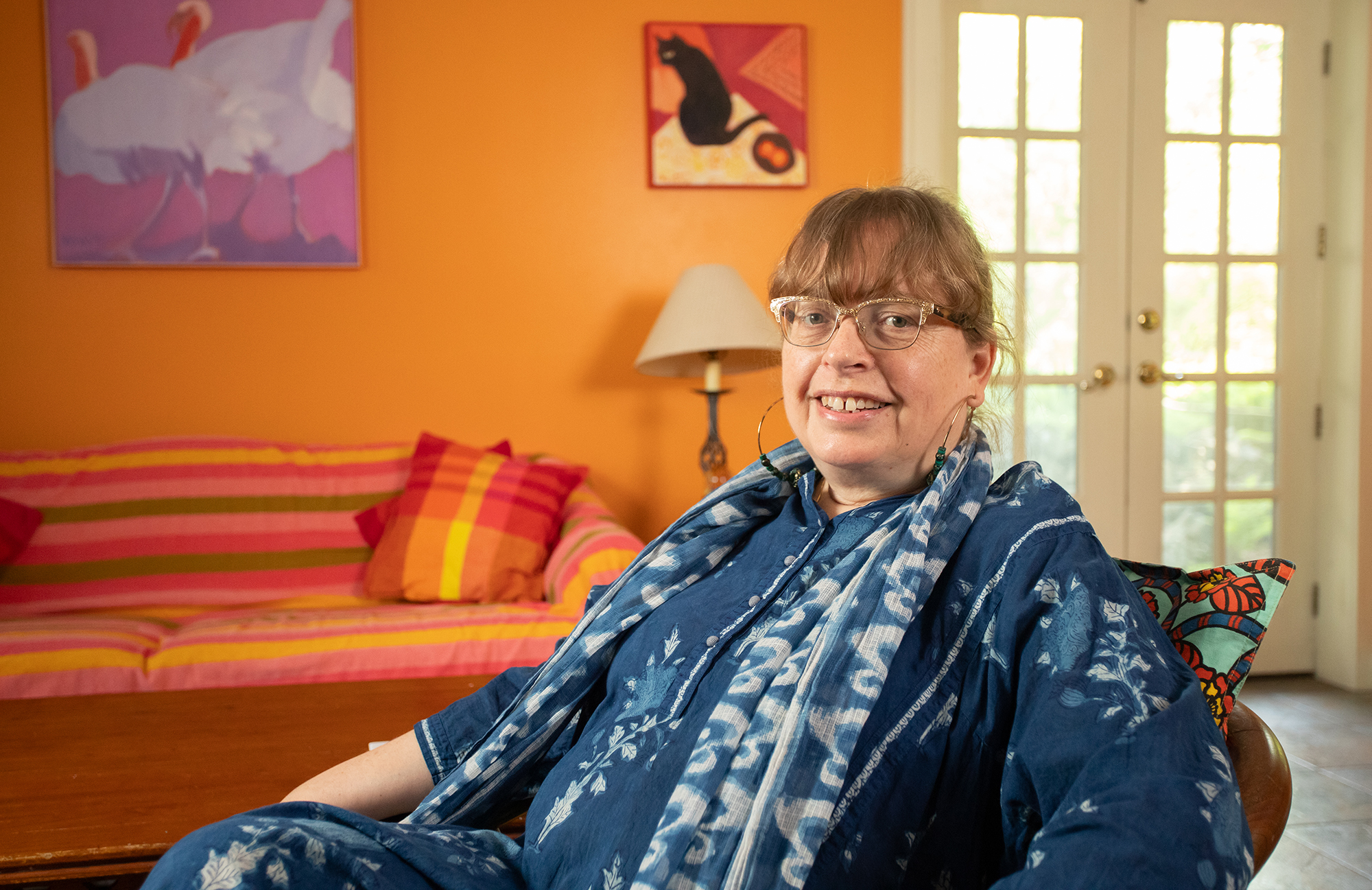
Daisy Rockwell, AB’91, AM’98, PhD’98, received the 2022 International Booker Prize for her translation of Geetanjali Shree’s novel Tomb of Sand. (Photography by Greg Nesbit)
Daisy Rockwell, AB’91, AM’98, PhD’98, sees literary translation as a creative act.
In the fall of 1989, Daisy Rockwell arrived in India for the first time, as one of two UChicago undergrads who’d signed up for a brand-new study abroad program organized—somewhat loosely, it turned out—by the renowned political economist and South Asia scholar Susanne Rudolph. The year before, Rockwell, AB’91, AM’98, PhD’98, had taken a course with Rudolph and loved it. Now she and a classmate were headed to a language school in the foothills of the Himalayas, several hours by car from Delhi. way.”
Almost immediately, things went awry. The driver whom Rudolph had hired came to pick up the students at the Delhi airport, but the hotel where they were supposed to stay that night had no record of a reservation. So instead he brought them to the American Institute for Indian Studies, where they slept on couches in the lounge until the director walked in the next morning. “Incensed to see these ragtag young people” lying around, Rockwell remembers, he ordered them out. Someone dropped them off at a guesthouse, but by now they were completely lost in a city they didn’t know, whose language they barely spoke, without a solid itinerary, and unsure of what to do next. “We were really scared,” she says. “We didn’t know anything.”
Before they’d left Chicago, Rudolph had given some basic instructions for getting to the school where they were enrolled for the quarter: Go to Kashmiri Gate in Old Delhi, find the taxi stand there, and book a ride. That was it. “Professor Rudolph … was terrifying but also an inspiration,” Rockwell says. In 1956, as a 20-something scholar, Rudolph had driven a Land Rover from Austria to India with her husband, Lloyd, to begin their research careers. “She had this terrifying idea of what a person could accomplish,” remembers Rockwell. “And no sympathy for weakness.”
And so, after finishing the breakfast that the concerned guesthouse staff had brought them, Rockwell and her classmate stepped out onto the street, opened up the map in their guidebook, and started walking.
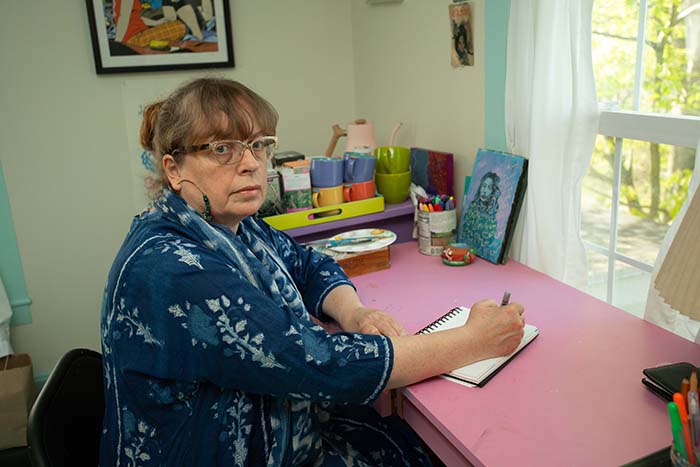
These days Rockwell is a translator, writer, and painter. Thirty-six years after that chaotic introduction, she’s still navigating her way around the subcontinent—its languages, its histories, its writers. In 2013 she began publishing translations of Hindi and Urdu literature, wading into both classic and contemporary texts, into fiction and poetry. From her New England home—a rambling century-old house in Vermont that she shares with her husband and teenage daughter, with brightly colored walls and a woodstove in the living room—Rockwell spends her days submerged in stories set half a world away: at a women’s college in Delhi, or a Pakistani refugee camp in the days after the partition, or on the streets of Lahore and Jalandhar.
Among her translations are works by celebrated authors such as Upendranath Ashk, Bhisham Sahni, Khadija Mastur, and Krishna Sobti, as well as up-and-comers like the young writer Shubham Shree, who shot to fame (and, in some quarters, infamy) in 2016 with “Poetry Management,” a poem criticizing the careerism of the literary world.
Rockwell’s fame came a few years later, in 2022, when she and Hindi novelist Geetanjali Shree won the International Booker Prize for Tomb of Sand (Tilted Axis Press, 2021), the English version of Shree’s Ret Samadhi. It’s a stunning 600-page epic that revolves around a matriarch who, after rousing herself out of a deep depression following her husband’s death, embarks on a seemingly abrupt journey from her home in northern India to Pakistan, where she revisits the trauma she experienced as a teenager during the partition and reunites with her first love. Confronting parts of herself that she’s kept secret from her family for decades, she undergoes a kind of rebirth. In her translator’s note at the end of the book, Rockwell writes, “Tomb of Sand is a tale woven of many threads, encompassing modern urban life, ancient history, folklore, feminism, global warming, Buddhism, and much more.”
For Rockwell, one of the book’s important threads has to do with translation itself as an art. Shree’s novel is full of experimentation. Sentences loop back on themselves, and linguistic echoes reverberate throughout the text. Wordplay is everywhere. In the translator’s note, Rockwell calls the book “above all a love letter to the Hindi language”—and re-creating it in a new language became a love letter, too. Rockwell’s translation is almost twice as long as the original, in part because capturing in English the meaning and sense of Shree’s Hindi experimentations required some linguistic experimentation from Rockwell herself, as she sought out what she calls “wordplays, echoes, etymologies, and coinages that feel Hindi-esque.”
Rockwell sometimes describes translation as “channeling,” or as a kind of “formalist” alchemy, fusing the translator’s understanding of the world with fidelity to the original text. Approaching Shree’s prose, Rockwell says, “I have to channel what I believe she would write, if she were me.” That’s an intuitive skill—“You can’t necessarily teach people how to channel something”—but also an intellectual one, involving what she calls the “linguistic biological element,” of “constantly thinking about root words” and the “kinds of words that are being put together on the page.”
Importantly, translation also requires something that other art forms don’t always embrace: humility. This is especially true, Rockwell says, for an outsider to the culture like her. “I can’t assume a position of infallibility,” she says. “I’m not even a native speaker of Hindi, so there are things that I could get wrong at any time.” When thorny problems crop up—an archaic phrase or unfindable reference—she asks for help, from South Asian friends and colleagues or, often, from the public. Rockwell regularly reaches out on social media in search of anyone who might recognize, for example, an esoteric game or food.
She rarely gets to ask the original writers those questions, because most of the authors Rockwell translates are either dead or quite elderly. “They’re like, ‘I don’t care anymore, do your magic,’” she says. One exception is Shree, with whom Rockwell kept up a vigorous back-and-forth throughout the two-and-a-half-year-long translation process. Recently the pair worked together again on Our City That Year (HarperVia), published in April. It’s Rockwell’s translation of a Shree novel based loosely on the 1992 demolition by Hindu extremists of a 16th-century mosque in northern India.
Having Shree close at hand was a blessing, but Rockwell has found that working with a living author is not as simple as asking questions and receiving answers. For one thing, she says, writers can’t always interpret the motivation or meaning behind their artistic decisions, because they don’t necessarily understand it themselves. And even the more quotidian translation dilemmas can get complicated. Shree speaks fluent English, “but she doesn’t speak my English,” Rockwell says—that of a native speaker—“and so there were a lot of things she didn’t understand that I was doing.” Sometimes the two writers argued; other times they agreed. In the end it was all productive. “It’s also just very hard sometimes for an author to see their book in a new language,” Rockwell says. “They can only see the original work, so they see the new English version as just this pale imitation.”
And yet Rockwell is careful not to impose her own English on the South Asian characters in her books. “I can’t make characters talk in such a way that they sound American, because there’s a way that Indians talk,” she says. Even in English, they must come across the same way they do in Hindi or Urdu. This and a million other details and considerations are the reason why Rockwell goes through about 10 drafts of each book. After a messy, handwritten rough draft, littered with notes and drawings and leaving all big questions aside, she types a second draft into her computer and starts reaching out for help with linguistic quandaries. By the fifth draft or so, she turns to the songs and poetry in the original text, to determine how—and how much—to translate them. It’s an endless exercise in second-guessing, in straining for polish and perfection.
That’s exactly the sense that one gets from a series of poems—her own poems—published last year in The Paris Review. The original intention, she says, was to write a book about translation, but when she sat down at her desk, the whole idea seemed impossibly boring: “Like, is it a how-to book? That’s just really drab.” What came out instead was poetry. Comic, touching, and piercingly spare, the poems—part of a larger book manuscript that she’ll publish later this year with Bloomsbury India as Mixed Metaphors—each attempt to explain what translation is. Rockwell compares it to a Lego set, Frankenstein’s monster, and a quilt constructed from paper: “It’s made of the wrong materials and put together / in a different way. / But it’s oddly beguiling! / This is translation.”
It makes sense that Rockwell would ultimately be drawn toward the artistic side of translation. Before she was a translator, she was an artist—a painter and a writer. In 2011 she published Little Book of Terror (Foxhead Books, 2011), an exploration of post-9/11 America that combined artwork, poetry, and essays. Her novels are cultural explorations, too, probing her own New England heritage: the disappearing world of old-money WASPs, a crumbling aristocracy.
Her debut novel, Taste (Foxhead Books, 2014), is a darkly comic character study of a young eccentric whose aesthetic obsessions lead him on what becomes a gruesome quest. In the forthcoming Alice Sees Ghosts (Bloomsbury India), a woman engaged to an Indian psychiatrist encounters the spirit of her dead grandfather while visiting her dying grandmother and is propelled by her visions to take a trip to India. Rockwell’s newest novel, still in progress, involves a pair of “ferociously menopausal” women detectives investigating a murder at a Vermont veterinary hospital. That book, she says, is the rare project that doesn’t require research; it’s drawn entirely from her own experiences, knowledge, and imagination: “Like making a quilt only out of fabrics that you have in your house.”
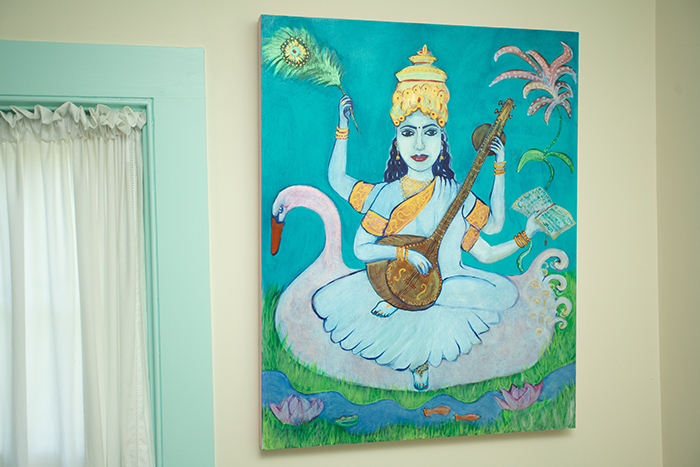
Rockwell grew up in a family of artists. Among them was her grandfather, the American icon Norman Rockwell. At least twice a week she and her father would go visit him for cocktail hour at his home in Stockbridge, Massachusetts. She remembers him as remote and taciturn, wholly absorbed in his artwork, until he grew too old to keep doing it and “just started to fade out.” She was nine when he died in 1978. When Rockwell herself started painting in art classes at school, “it was always assumed,” she says, “that my grandfather was the biggest influence,” and that her talent was “a straight genetic import” from him, rather than something her own.
But in fact, her grandfather was only one of three “overbearing, overwhelming” artists in her life. The other two were her parents, Jarvis Rockwell and Susan Merrill, who divorced when Rockwell was five but remained friends. “They split the world between them,” she says. “He was the detail person, and she was shapes and colors.” Her mother, who became known for vivid, off-kilter paintings of farm animals, once brought a new refrigerator home and, “aghast at how it was just this big white block in the middle of the kitchen,” Rockwell recalls, painted a huge duck on it. “She saw everything through an artistic lens,” Rockwell says. She’d begin telling a story about her day—who she saw, what they were wearing—and end up sketching it out, her hand sweeping across the page as she spoke.
Rockwell’s father, meanwhile, would spend months on tiny ink drawings of structures and patterns. He took apart adding machines and arranged the pieces in alternate configurations. In 1979 he began collecting action figures—hundreds of thousands of toy soldiers, Japanese monsters, Pez dispensers, Star Wars figurines, bobbleheads, Troll dolls, Betty Boops—and assembled them on tiny plastic furniture as though they were talking to each other. These “whimsical and distressing” installations, one museum’s 2018 exhibition announcement read, captured “the complexities and outlandishness of our own existence.”
Once, when Rockwell was a child, her parents’ television broke, and when they couldn’t figure out how to fix it (“they had absolutely no ability to put up an antenna or anything like that”), they took it behind the house and threw an axe at it. “And then my father got the insides, which he kept taking apart bit by bit, spreading them out like a feast,” Rockwell says, “and my mother got the outside. She took a muffler that fell off her car and put it in the TV shell, and then painted it these bright colors, and it became a sculpture.” Rockwell laughs. “So that’s kind of what they were like in a nutshell: very, very impractical people who were single-mindedly driven artistically.”
Growing up, all this was inspiring, but also oppressive. One reason Rockwell chose UChicago was because at the time it didn’t have an intense focus on the creative arts. “It wasn’t a place to go if you wanted to be an art major,” she says. Instead, the College was a leap in the opposite direction, toward the “old, hard intellectual experience” she craved. She arrived on campus planning to study classics—she’d been learning Latin since seventh grade, and her first year in the College, she added Greek.
And then, as a second-year student, she enrolled in a Hindi class on a whim. Suddenly, a window opened. Compared to classics, Hindi felt like a fresh adventure. (“When you’re in classics,” she explained to one interviewer a few years ago, “everything’s been picked over. People are just analyzing the use of an accent mark.”) Rockwell changed her concentration to South Asian languages and literatures and then continued on for a PhD. She took courses in Tamil and Sanskrit and studied a bit of Malayalam—and would later become serious about Urdu—but early on, Hindi, with its musical inflections and back-of-the-throat consonants, occupied her single-minded focus. It took five years, she says, to feel “in the swim of things” in conversation, and honing her grasp of the language’s nuances has been the work of decades. After earning her PhD, she taught at Loyola University Chicago before taking a job as vice chair for the Institute of South Asia studies at the University of California, Berkeley. When she left there in 2006, she was burned out on academia and increasingly uncomfortable with the field’s orientalist roots and ties to colonialism. She didn’t have a plan for what to do next.
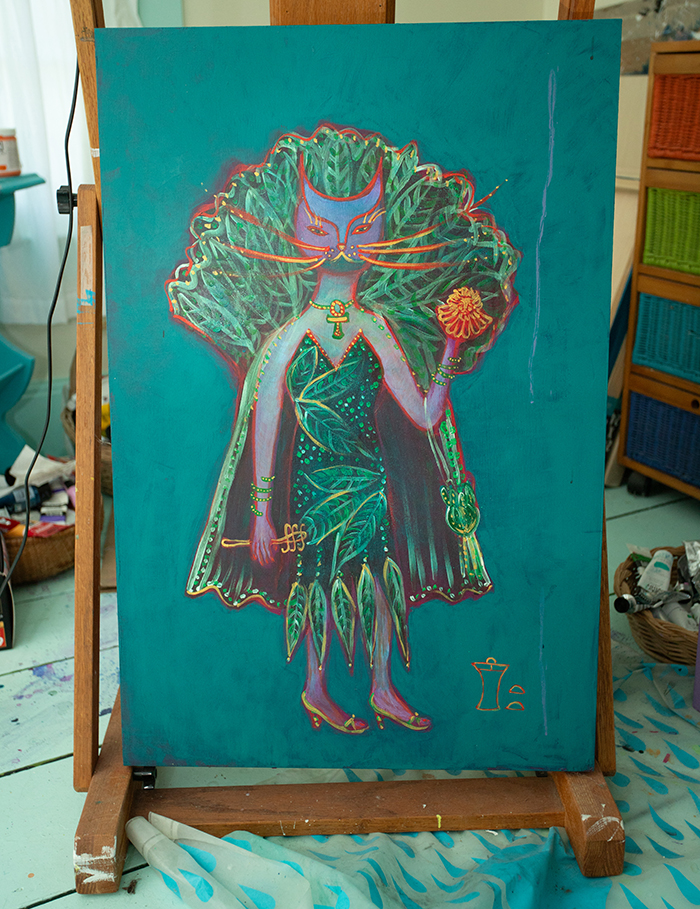
At first, she turned to art. It had been 15 years since she stopped painting, and now work began pouring out of her. She and her husband, psychiatrist Aaron York, AB’91, MD’05, were living in Palo Alto, California, while he completed his Stanford residency, and she signed up for an etching class at a community art school. “I don’t know why, but for some reason,” she says, the first image she decided to make was of Muhammad Ali Jinnah, the founder of Pakistan and the person perhaps most responsible for the partition of the subcontinent in 1947. She continued painting and drawing Jinnah over and over again, dozens of obsessive images, often in playfully lurid colors—plum, mint green, popsicle orange.
These days Jinnah is just one of many geopolitical figures in a portfolio that also includes Narendra Modi, Vladimir Putin, and members of the Trump family—almost always rendered with a dose of Rockwell’s quirky irony and plenty of glitter. Her Flickr stream includes more than 500 paintings and drawings, with subjects ranging from Indian pop culture to the “quarantine art” she produced during the pandemic’s early months. Some of her most beautiful and beguiling pieces incorporate Urdu calligraphies of American poems: Robert Frost’s “Stopping by Woods on a Snowy Evening,” Emily Dickinson’s “‘Hope’ Is the Thing with Feathers.”
In 2010 an email from a comparative literature graduate student led her back to translation. He was translating a Hindi play (“I think about Jinnah,” she says) and wanted permission to use one of her paintings on the cover—although she soon discovered that what he really wanted was to talk about her academic work, which was related to his dissertation topic. “I had given interviews where I was really dismissive of academia, and so he didn’t think he could approach me with that straightforwardly,” she says. During their correspondence, she told him about a manuscript of short stories she’d translated, and he encouraged her to submit it to his editor at Penguin Random House India. “And she accepted it and then encouraged me to translate more,” Rockwell says. “So I sort of fell back into translation.”
Early in grad school, she’d taken a seminar with poet and linguist A. K. Ramanujan, who encouraged students to make their translations not just useful but well written. (“Every footnote is a confession of failure,” he taught them, one of many aphorisms that still guides Rockwell’s practice.) Her first publication—the manuscript she sent to Penguin Random House India—was Hats and Doctors (Penguin Books, 2013), a collection of Hindi short stories by Updendranath Ashk, who’d been the subject of her dissertation. Next she published Ashk’s Falling Walls (Penguin Books, 2015), a novel she’d first begun translating as a student 20 years earlier, a bildungsroman about an aspiring writer in 1930s India and lower-middle-class family life. Rockwell often describes the authors she translates as her “teachers,” and Ashk was one of the first.
More recently, Rockwell has developed an unapologetic favoritism for women writers and feminist themes. This matches the “literary diet” she keeps as a reader: “When you read women only, you start to realize how you inure yourself to misogyny and objectification,” she says. She also gravitates toward books about the partition and its aftermath, an entire genre in South Asian writing. (One of Rockwell’s early fixations as a student was Yashpal’s Jhutha Sach, a massive two-volume novel that narrates the events surrounding the partition in gripping journalistic detail.) “It’s an epochal period in history but it’s also an interesting trope in literature,” she says, “because it’s this juncture at which everything transforms, and anything is possible. Literally, people woke up not knowing what country they were in.”
Her readers understand this already, because most of them are South Asian themselves or part of the diaspora. Some may speak other languages of the subcontinent, but for many, Hindi and Urdu are mother tongues that have grown unfamiliar. “These are people who have become alienated from their first language, even though they belong to it,” Rockwell says. Partly this is a result of colonialism and an education system that steers students away from their own culture. Partly it’s global capitalism and the hegemony of English. Rockwell has mixed feelings about all of it, especially her own role as an English translator (one of her Paris Review poems is titled “English Is a Monocrop”), but she’s come to think of her audience, she says, as a “big tent,” and she’s trying to keep everyone inside it. For readers who speak some Hindi and Urdu, that means leaving some jokes or expressions in the original language, while also translating them for everyone else. “I try to think of ways to reach out with my use of language, to invite people into the text, back into the original language.”
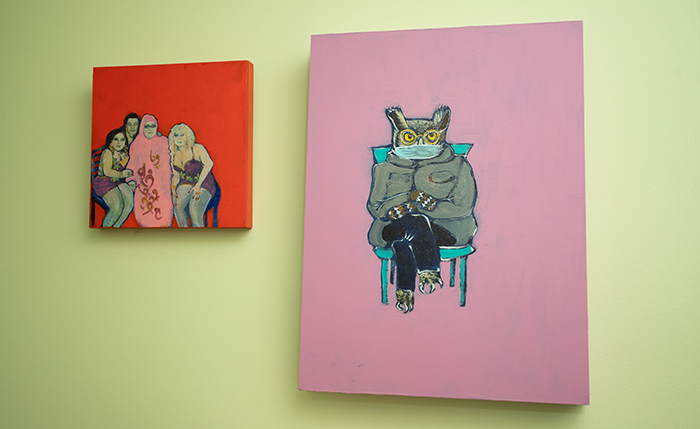
She could never have imagined all this back in 1989, during that first overwhelming immersion in India. After Rockwell and her classmate muddled their way to Kashmiri Gate as Susanne Rudolph had instructed, they eventually found a taxi and began winding their way toward the Himalayas. The trip was slightly harrowing and everything still felt disorienting, but finally they were on their way.
As the car climbed into the mountains, the road tightened into hair-raising switchbacks. Then it started to rain. The taxi driver never turned on the windshield wipers, and instead reached his arm out the window periodically, wiping the glass with a little cloth. By the time they arrived at the school, on a peak covered in pine trees, it was dark. Later the sun would come up and Rockwell would see how gorgeous it all was, but for now they couldn’t even see the building. The driver got out of the car and walked into the night; about 15 minutes later, a teacher appeared at the window with an umbrella. “Hi,” she said. They’d arrived. But for Rockwell, the journey had only begun.
Lydialyle Gibson is an associate editor at Harvard Magazine.
